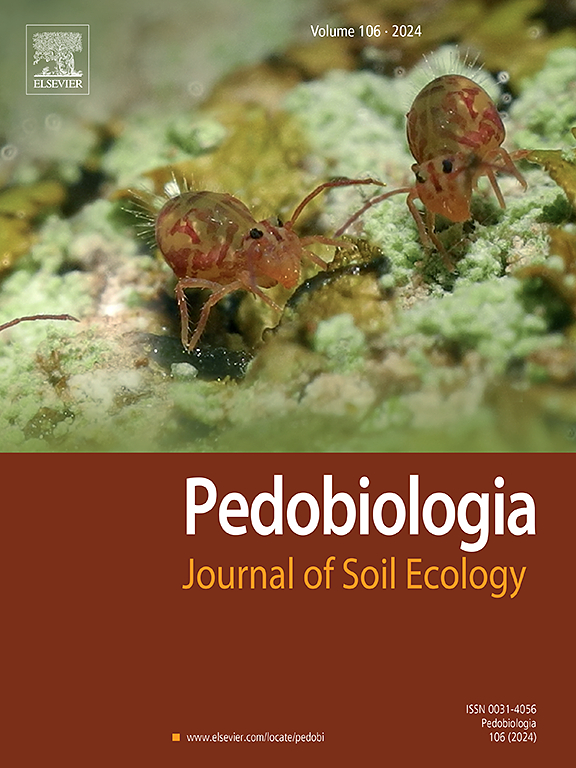Litter decomposition of epiphytic lichens, bryophytes, and vascular plants on the forest floor and canopy in a cool-temperate old-growth forest
IF 2.2
3区 农林科学
Q3 ECOLOGY
引用次数: 0
Abstract
The litter of non-vascular plants, such as epiphytic lichens and bryophytes, contributes to soil formation in the forest floor and tree canopy of old-growth forests. In this study, we investigated litter decomposition to elucidate the ecological functions of non-vascular plants in forest ecosystems. Focusing on a cool-temperate old-growth forest in Japan, we conducted litter bag experiments to examine rates of change in the mass of litter from epiphytic lichens, epiphytic bryophytes, and vascular plants (host tree leaves) after three months and one year. Litter bags were installed at three microsites: on the ground, in thick canopy soil, and in thin canopy soil. The results showed that lichen and bryophyte litter decomposed more slowly than vascular plant litter in ground and thick canopy soil. No significant differences in mass loss rates were observed between the ground and thick and thin canopy soils. However, the contributions of lichens and bryophytes to decomposition at the ground and canopy levels were slightly influenced by environmental variables, such as soil temperature, soil volumetric water content, and canopy openness. A litter bag experiment with a mixture of the three litter species showed no general synergistic effect of mixed litter on vascular plants. This study provides insights into the ecological functions of non-vascular plants in forest ecosystems, emphasizing their role in the dynamics of litter decomposition.
寒温带原始森林地表和树冠上附生地衣、苔藓植物和维管植物凋落物的分解
非维管植物的凋落物,如附生地衣和苔藓植物,有助于在原生林的森林地面和树冠形成土壤。本研究通过研究凋落物分解来阐明非维管植物在森林生态系统中的生态功能。以日本寒温带原生林为研究对象,进行了凋落物袋实验,研究了3个月和1年后附生地衣、附生苔藓和维管植物(寄主树叶)凋落物质量的变化率。在地面、厚冠层土壤和薄冠层土壤三个微点设置凋落物袋。结果表明:地衣和苔藓凋落物在地上和厚冠层土壤中比维管植物凋落物分解慢;土壤和厚、薄冠层土壤的质量损失率无显著差异。地衣和苔藓植物对地表和冠层分解的贡献受土壤温度、土壤体积含水量和冠层开度等环境变量的影响较小。三种凋落物的混合凋落物袋试验表明,混合凋落物对维管植物没有普遍的增效作用。本研究揭示了非维管植物在森林生态系统中的生态功能,强调了它们在凋落物分解动力学中的作用。
本文章由计算机程序翻译,如有差异,请以英文原文为准。
求助全文
约1分钟内获得全文
求助全文
来源期刊

Pedobiologia
环境科学-生态学
CiteScore
4.20
自引率
8.70%
发文量
38
审稿时长
64 days
期刊介绍:
Pedobiologia publishes peer reviewed articles describing original work in the field of soil ecology, which includes the study of soil organisms and their interactions with factors in their biotic and abiotic environments.
Analysis of biological structures, interactions, functions, and processes in soil is fundamental for understanding the dynamical nature of terrestrial ecosystems, a prerequisite for appropriate soil management. The scope of this journal consists of fundamental and applied aspects of soil ecology; key focal points include interactions among organisms in soil, organismal controls on soil processes, causes and consequences of soil biodiversity, and aboveground-belowground interactions.
We publish:
original research that tests clearly defined hypotheses addressing topics of current interest in soil ecology (including studies demonstrating nonsignificant effects);
descriptions of novel methodological approaches, or evaluations of current approaches, that address a clear need in soil ecology research;
innovative syntheses of the soil ecology literature, including metaanalyses, topical in depth reviews and short opinion/perspective pieces, and descriptions of original conceptual frameworks; and
short notes reporting novel observations of ecological significance.
 求助内容:
求助内容: 应助结果提醒方式:
应助结果提醒方式:


